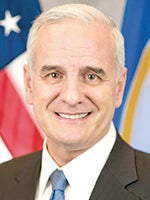Dayton reveals water quality wish list; Two Mower projects make the cut
Published 10:43 am Friday, January 15, 2016
Associated Press and Austin Daily Herald
Two Mower County projects made Gov. Mark Dayton’s $220 million wish list to upgrade ailing sewage networks, wastewater plants and drinking water treatment facilities across the state, his latest bid to boost Minnesota’s water quality.
The proposal would have lawmakers borrow money for dozens of infrastructure improvements, including $1.8 million to connect an unsewered part of Austin Township, dubbed Turtle Creek 2, to the Austin’s sewer system and $521,000 for improving a water rehabilitation system in LeRoy.
The Turtle Creek 2 project began last year to connect more than 30 Austin Township properties to city of Austin’s sewer system, but the project is expected continue this year.
Dayton’s water plan announced Thursday is just a portion of a larger public construction package that Dayton is proposing; it’s expected to be released in full Friday.
Though Dayton and other state officials said the extra cash would triple or quadruple the number of infrastructure projects the state is able to sponsor, they said it would only chip away at an estimated $11 billion in upgrades needed over the next two decades.
Dayton said he envisions it as just the first step in a continuous series of investments over the next 20 years.
“It’s a multifaceted problem. It’s not one that we’ll be able to resolve overnight,” Dayton said.
His plan falls squarely in line with his promise to make improving water quality a top priority in his final term, and it comes on the heels of a law passed last year that required larger buffer strips between crops and public waterways. His latest proposal includes some funding to compensate farmers for implementing those buffers.
But the long list of projects primarily targets cash-strapped cities and towns struggling to pay to overhaul aging sewer systems and outdated treatment facilities. For example, public works employees in Minneota have resorted to removing stubborn human waste with long sticks to keep its ancient sewer lines flowing, so Dayton’s plan would provide the southwest Minnesota town with $2.1 million.
“These are infrastructure systems like roads and bridges and everything else. They wear out over time,” said Jeff Freeman, executive director of the Minnesota Public Facilities Authority.
Dayton conceded the number and scope of projects would likely get whittled down once the Legislature’s session begins March 8, due to lawmakers’ own ideas of how much money should be borrowed.
“Whatever we do is not going to be enough,” he said.






